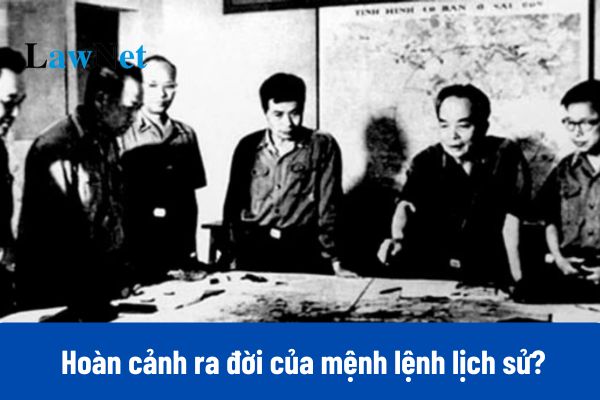Vietnam: What is the advent context of the historical order: "Faster, Faster Yet; Bolder, Bolder Yet"? What is its historical value towards the Great Spring Victory of 1975?
What is the advent context of the historical order: "Faster, Faster Yet; Bolder, Bolder Yet"? What is its historical value towards the Great Spring Victory of 1975?
(1) The advent context of the historical order: "Faster, Faster Yet; Bolder, Bolder Yet"
The famous historical order "Faster, faster yet; bolder, bolder yet..." signed by General Vo Nguyen Giap on April 7, 1975, is regarded as one of the most crucial decisions in the final stages of the resistance war against the United States for national salvation. This historical order functioned as a "call" urging our military and civilians to accelerate the pace of attacks, seizing the strategic opportunity to achieve a decisive victory, completely liberating the South and reuniting the country.
Before this, from late 1974 to early 1975, significant shifts occurred on the Southern battlefield. By the end of 1974, the Central Military Commission assessed that the Saigon army was weakened, with its fighting morale seriously diminished. Our Communist Party of Vietnam recognized that the strategic opportunity was ripe and decided to launch a General Offensive and Uprising across the entire Southern battlefield.
In March 1975, our forces achieved resounding victories in the Central Highlands campaign, especially with the unexpected attack on Buon Ma Thuot on March 10, 1975, which led to the collapse of the enemy's entire defensive system in the Central Highlands. Responding to this situation, the Politburo and the Central Military Commission decided to accelerate the offensive to fully exploit the enemy's panic. Following the Central Highlands, our forces continuously defeated the enemy in Hue, Da Nang, Nha Trang, Phan Rang, leading to the large-scale disintegration of the Saigon government's defense system.
On March 25, 1975, the Politburo convened and resolved to seize this opportunity to completely liberate the South as quickly as possible. The meeting on the morning of March 31 arrived at a historic decision: to launch a full-scale attack on Saigon, with the action strategy being "fast, bold, unexpected, sure victory."
Following the meeting, General Vo Nguyen Giap, as the General Commander of the Vietnam People's Army, contemplated deeply on the final strategic decisive battle. On April 1, 1975, he communicated to the Southern battlefield, emphasizing that time was now a decisive factor. The enemy could anticipate our attack on Saigon but presumed that it would require at least 1-2 months for preparations. Thus, time became the greatest surprise factor.
On April 4, 1975, General Vo Nguyen Giap sent a dispatch to officers and soldiers of the 2nd Corps on the move:
"Comrades, you are embarking on a very glorious mission. Act with speed, boldness, surprise, and certainty of victory..."
By April 7, 1975, to expedite the movement and prepare for the final decisive battle, General Vo Nguyen Giap issued an urgent order:
"Faster, faster yet. Bolder, bolder yet. Seize every hour, every minute, rush to the front, liberate the South. Fight decisively and gain complete victory!"
This urgent dispatch was immediately transmitted by the Cipher Committee across all fronts to each unit on the Southern battlefield.
(2) Its historical value towards the Great Spring Victory of 1975
This order had tremendous significance, contributing decisively to the resounding success of the Ho Chi Minh Campaign and the Great Spring Victory of 1975.
(1) Accelerating the Pace of Attack, Denying the Enemy the Chance to Counterattack
Upon receiving General Vo Nguyen Giap's order, the entire army rushed forward at the highest possible speed. Units moved day and night, overcoming harsh terrain and severe weather, crossing rivers, streams, and forests, defeating enemies along the march while ensuring maximum speed. Consequently, our forces promptly surrounded and isolated Saigon before the enemy could organize a defense.
(2) Creating a Surprise Factor in Time, Leaving the Enemy Completely Shocked
The U.S. and the Saigon government, although aware that the liberation forces would attack Saigon, did not anticipate such a swift offensive. They believed that our forces needed at least a few weeks to gather strength, but in reality, the liberation forces approached Saigon within days. This left the enemy unable to organize defenses, leading to the rapid collapse of the Saigon government.
(3) Generating a Powerful Momentum, Enhancing the Determination to Fight
General Vo Nguyen Giap's order served as a call to the soldiers, urging every officer and soldier to exert all their strength for the final victory. As recounted by Lieutenant General Pham Hong Cu:
"The General's order was like a call from the country's mountains and rivers. Upon receiving this order, our forces seemed to gain new strength, marching with enthusiasm, rapidly advancing towards Saigon."
(4) Creating Momentum for the Ho Chi Minh Campaign's Rapid Victory
By effectively implementing this order, the wings of the army advanced towards Saigon as planned. On April 26, 1975, the Ho Chi Minh Campaign officially commenced. After five days of rapid advance, precisely at 11:30 a.m. on April 30, 1975, our forces entered the Independence Palace, and the President of the Saigon government, Duong Van Minh, declared unconditional surrender.
The General Offensive and Uprising of Spring 1975 concluded with a comprehensive victory, completely liberating the South and achieving national reunification.
Note: Information is for reference purposes only!

What is the advent context of the historical order: "Faster, Faster Yet; Bolder, Bolder Yet"? What is its historical value towards the Great Spring Victory of 1975? (Image from the Internet)
What are the criteria for assessing educational results for 9th-grade History in Vietnam?
According to the General Education Program for History and Geography issued in Circular 32/2018/TT-BGDDT, the criteria for assessing educational results for History in Vietnam are as follows:
The assessment of educational results in History and Geography must meet the following requirements:
- The assessment aims to provide accurate, prompt, and valuable information regarding the degree to which the educational program's requirements are met and the progress of students, guiding and adjusting the teaching activities of teachers and the learning activities of students.
- The basis for assessment is the essential quality requirements, common competencies, and specific history and geography skills outlined in the overall program and the History and Geography curricula;
- In addition to the theoretical content, it is necessary to enhance the assessment of students' skills, such as working with maps, atlases, diagrams, tables, and photographs, observing, collecting, processing, and systematizing information, using outdoor learning tools, employing technology and information communication in learning, etc; assess the ability to apply knowledge to specific situations, rather than focusing solely on the ability to recall historical or geographical knowledge.
- It is necessary to diversify assessment forms and enhance regular assessments for all students through various methods: observation of classroom activities; assessment through learning profiles, and learning products; assessment through project performance reports, practical application results, and presentations of learning task results; create conditions for students to participate in the assessment process of educational results.
- Educational results are evaluated both qualitatively and quantitatively through regular and periodic assessments, based on which a comprehensive assessment of student qualities, competencies, and progress is compiled.
What are the objectives of the 9th-grade History curriculum in Vietnam?
According to the General Education Program for History and Geography issued in Circular 32/2018/TT-BGDDT, the objectives of the 9th-grade History curriculum in Vietnam are as follows:
- The History and Geography subject at the lower secondary level contributes, along with other subjects and educational activities, to the formation and development of students' essential qualities and common competencies.
- At the lower secondary level, the History and Geography subject forms and develops in students competence in history and geography based on foundational and selective knowledge of world, national, and local history, geography; natural processes, socio-economic and cultural processes taking place in space and time; the interaction between human society and the natural environment; helps students know how to use the tools of historical and geographical sciences for learning and practical application;
Simultaneously, it contributes, along with other subjects and educational activities, to the formation and development of students' essential qualities and common competencies, particularly fostering the love for homeland and country, pride in national traditions, respect for the diversity of world history and human culture, and inspiring students to explore the world around them and apply what they have learned in real life.

